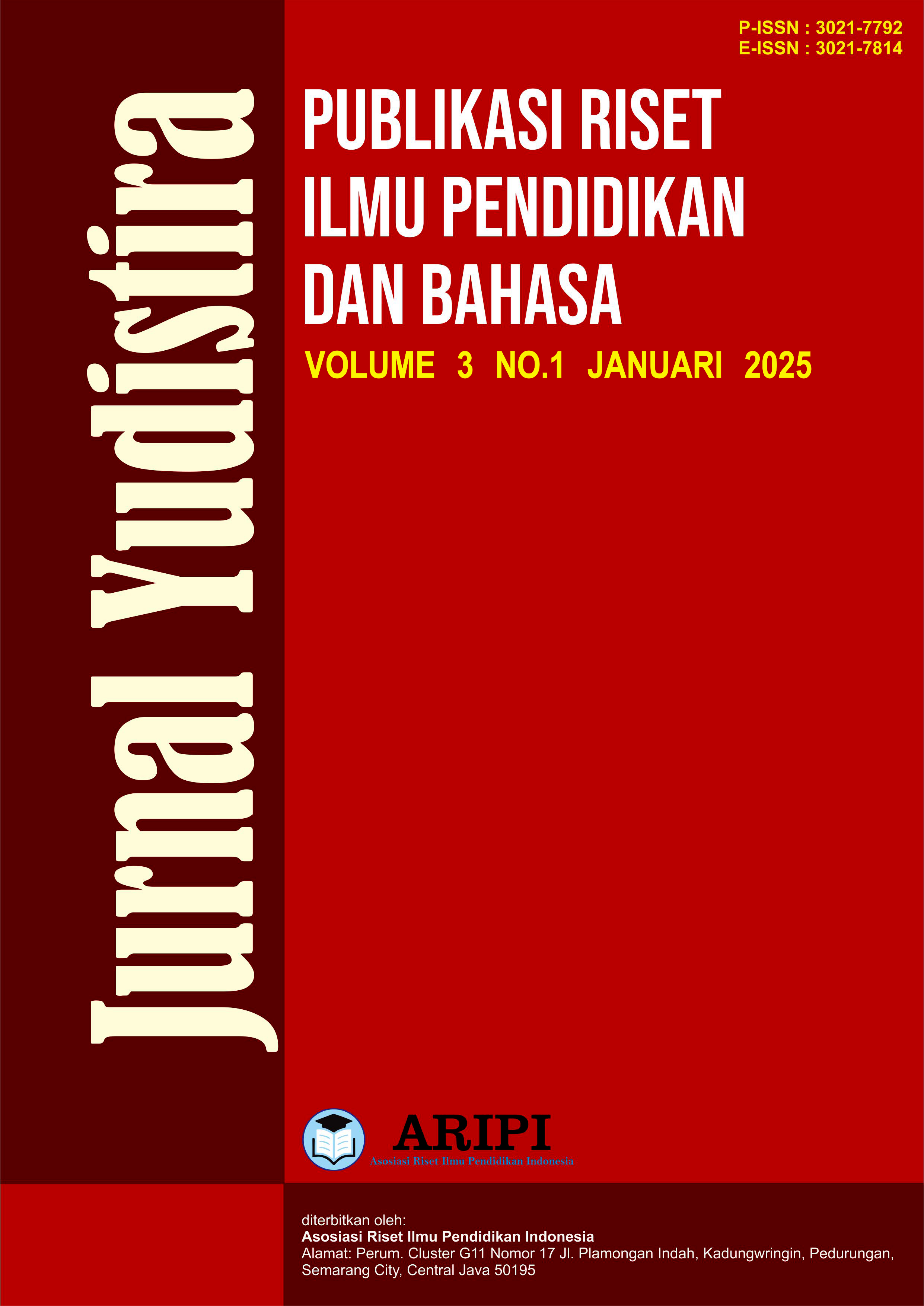Makna Konotatif Konten Youtube Dr. Richard Lee: Kiki Putra Bongkar Kecurangan UN
DOI:
https://doi.org/10.61132/yudistira.v3i1.1364Keywords:
Meaning, Connotation, Content, YouTubeAbstract
For humans, language functions as a vital communication tool in life because language is a communication tool for humans or society to interact, and words are useful in conversation. The thing that will be discussed in this research is connotative meaning, namely the meaning of impressions or associations that are usually emotional in nature that are evoked by a word regardless of the boundaries of the dictionary or its basic definition. The aim of this research is to explain the connotative meaning contained in Dr. YouTube. Richard Lee: Kiki Putra Exposes UN Fraud. In analyzing YouTube content, researchers used a qualitative approach and the type of research was descriptive qualitative. The results of this research contain 10 statements of connotative meaning, including the following: 1). Silence, 2). Buying a chair, 3). Overslept Hero, 4). You are handsome, you are a wolf, 5). Government eyes, 6). Shoot at UI, 7). Mummy, 8). Humble, 9). If you attend high school, 10). Dropout.
Downloads
References
Basri, S., & Sari, E. (2019). Tari Remo (Ngremong): Sebuah analisis teori semiotika Roland Barthes tentang makna denotasi dan konotasi dalam tari Remo (Ngremong). GETER: Jurnal Seni Drama, Tari dan Musik, 2(1), 55–69.
Benedicta, F., & Paramita, A. C. (2022). Fashion sebagai identitas masyarakat urban pada konten YouTube Yoshiolo. Jurnal Communio: Jurnal Jurusan Ilmu Komunikasi, 11(2), 220–240.
Chaer, A. (2007). Linguistik umum. Rineka Cipta.
Chaer, A. (2012). Linguistik umum. Rineka Cipta.
Ievansyah, & Sadono, T. P. (2018). Personal branding dalam komunikasi selebritis (Studi kasus personal branding alumni Abang None Jakarta di media sosial Instagram). Bricolage, 4(2), 150–209.
Keraf, G. (2004). Komposisi: Sebuah pengantar kemahiran bahasa. Nusa Indah.
Kridalaksana, H. (2008). Kamus linguistik (edisi keempat). Gramedia Pustaka Utama.
Ma’arif, M. S., & Widadt, W. (2023). Analisis makna denotatif dan konotatif berita konflik Palestina dan Israel dalam kabar berita harian Kompas.com edisi Mei 2021. Jurnal PENEROKA: Kajian Ilmu Pendidikan Bahasa dan Sastra Indonesia, 3(1), 14–30.
Mahsun. (2012). Metodologi penelitian bahasa: Tahapan strategi, metode, dan tekniknya. PT. Rajagrafindo Persada.
Moleong, L. J. (2017). Metodologi penelitian kualitatif (Revisi). PT. Remaja Rosdakarya.
Nathaniel, A., & Sannie, A. W. (2020). Analisis semiotika makna kesendirian pada lirik lagu “Ruang Sendiri” karya Tulus. SEMIOTIKA: Jurnal Ilmu Sastra dan Linguistik, 19(2), 107–117.
Nofitria Anri, & Casanova, R. (2024). Wacana dan pragmatik. CV. Eureka Media Aksara.
Paramita, F. B. A. C. (2016). Tubuh perempuan dan kekuasaan (Representasi tubuh perempuan dalam video klip Beyoncé Pretty Hurts). 45–72.
Pascarina, P. A. (2014). Representasi identitas remaja laki-laki melalui penggunaan fashion. Journal Unair, 3(2), 1–12.
Pattipeilohy, S. Y. E., & Wijaya, Y. (2018). Kajian teologi moral.
Richard. (2024). Kiki Putra bongkar kecurangan UN, lulus paket C. https://youtu.be/sO2O5dc3qd8?si=B4YXWOjteiFHFHco
Septiana, R., Kalangi, L. M., & Timboeleng, D. R. (2019). Makna denotasi, konotasi, dan mitos dalam film Who Am I Kein System Ist Sicher (Suatu analisis semiotik). Jurnal Elektronik Fakultas Sastra Universitas Sam Ratulangi, 1(2).
Sinaga, Y. C., Cyntia, S., Komariah, S., & Barus, F. L. (2021). Analisis makna denotasi dan konotasi pada lirik lagu Celengan Rindu karya Fiersa Besari. METABASA, 3(1).
Subet, M. F., & Daud, M. (2019, March 14). Makna denotatif dan konotatif dalam slanga pelacur. https://doi.org/10.31226/osf.io/9qjpe
Tarigan, H. G. (1985). Menulis sebagai suatu keterampilan berbahasa. Angkasa.
Tarigan, H. G., & Tarigan, D. (1995). Pengajaran analisis kesalahan berbahasa. Angkasa.
Walija. (1996). Bahasa Indonesia dalam perbincangan. IKIP Muhammadiya Jakarta Press.
Downloads
Published
How to Cite
Issue
Section
License
Copyright (c) 2024 Jurnal Yudistira : Publikasi Riset Ilmu Pendidikan dan Bahasa

This work is licensed under a Creative Commons Attribution-ShareAlike 4.0 International License.






